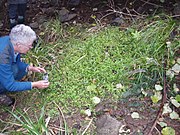pt-BR
nomes no trilho de navegação


Mentha cunninghamii, known commonly as New Zealand mint or Māori mint,[3] is a species within the Mentha (mint) genus, endemic to New Zealand.[4][5]
The plant was named to honor English botanist Allan Cunningham, who was known for his plant collections in Australia and New Zealand.[6] In addition to its English-language names, several Māori language common names for the plant are also attested, including: hīoi,[7] moki and mokimoki.[8][9] The latter is a term also used for the unrelated ferns Microsorum scandens and Doodia caudata.[10]
Mentha cunninghamii shares a mint odor with other species within the Mentha genus, but in appearance is very distinct from many other mints.[6] It has been suggested that it may actually be more closely related to members of the Micromeria genus.[11]
It is a slender, wiry, prostrate perennial plant, with a creeping rhizome. The plant is much branched, often matted, with numerous stems arising from the rhizome, diffusely branched, pubescent, growing from two to twelve inches long.[12] Its leaves are shortly petiolate or nearly sessile, 1/6 to 1/2 inches long, broadly ovate or almost orbicular, obtuse, entire or with an obscure notch on each side, and glandular-dotted. Its flowers are small, white, axillary, usually solitary but sometimes with two to three in each axil. Its peduncles are slender and variable in length. Its calyx are about 1/8 inches long, tubular-campanulate in shape, densely hairy, with teeth villous within. Its corolla-lobes are almost equal, flat and spreading, with the upper one shortly bifid. Its stamens protrude equally with the corolla or are slightly exserted.[12]

Mentha cunninghamii is endemic to the four islands of North Island, South Island, Chatham Island and Stewart Island in New Zealand.[6] It is found sparsely in grassy fields and open land generally.[13][14] It inhabits an elevation range from coastal to alpine, within a range of sea level to 4,500 feet (1,400 metres).[12] Sources variously describe its flowering season as beginning in the Southern Hemisphere in either September[4] or November,[15] ending in April.[6]
As of 2018, New Zealand's Department of Conservation's New Zealand Threat Classification System (NZTCS) assesses Mentha cunninghamii's conservation status as "At Risk: Declining."[1] The system uses the Declining status to indicate populations that currently possess large populations, but are experiencing declines that could eventually lead to a listing as "Threatened."[16]
Mentha cunninghamii has been used by New Zealand's Māori people as a diaphoretic (meant to induce sweating). The leaves are also used for their scent, including in cooking.[3] It is described as easily cultivatable in many gardens.[17]
Mentha cunninghamii, known commonly as New Zealand mint or Māori mint, is a species within the Mentha (mint) genus, endemic to New Zealand.